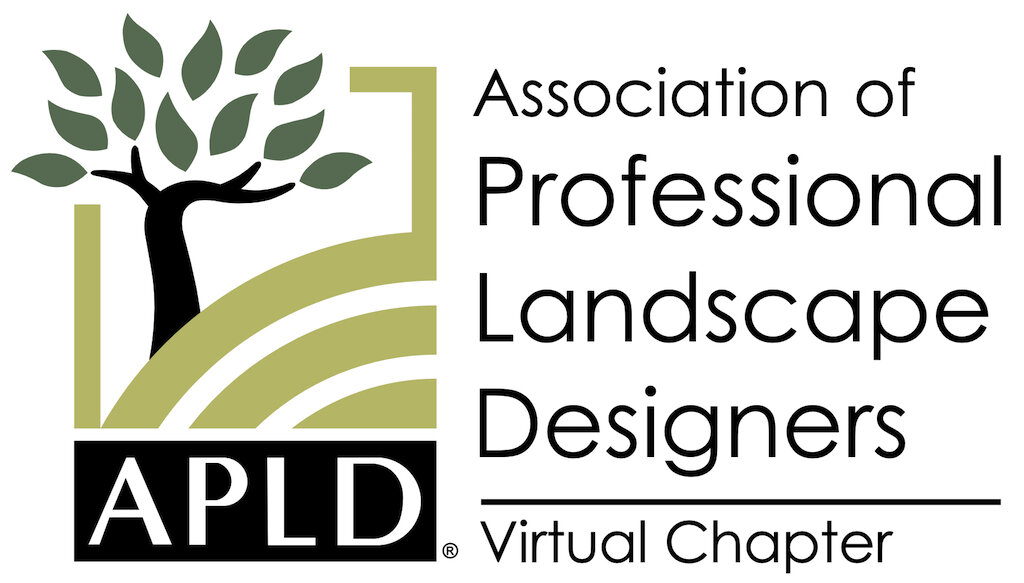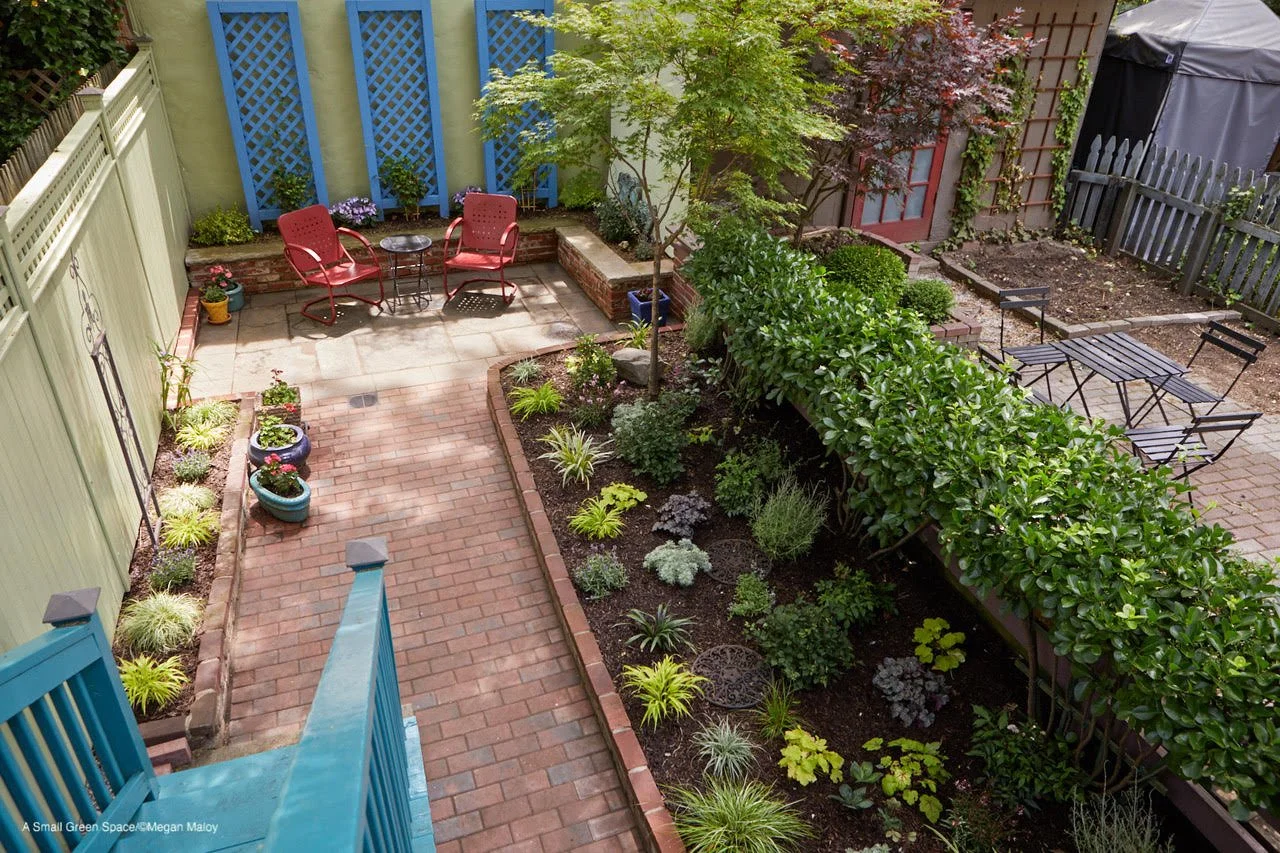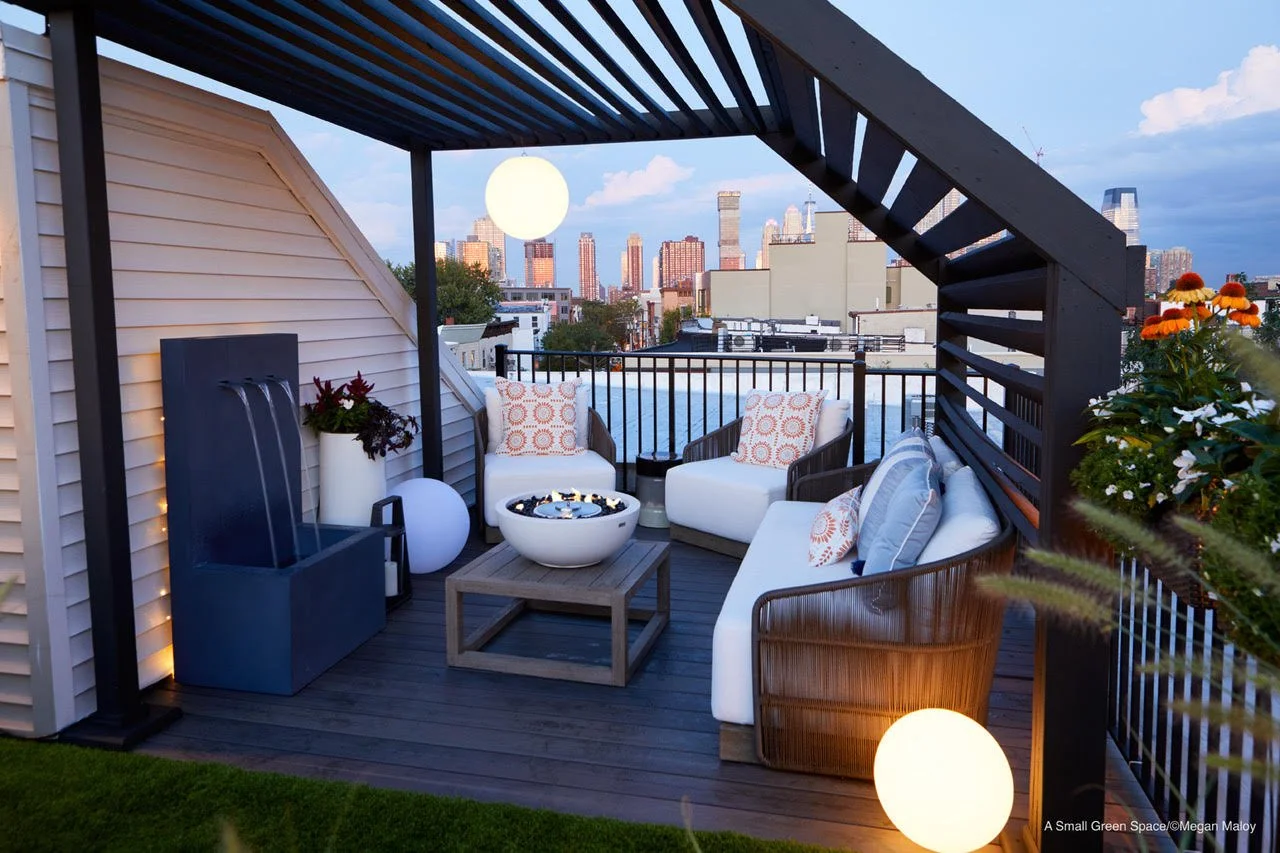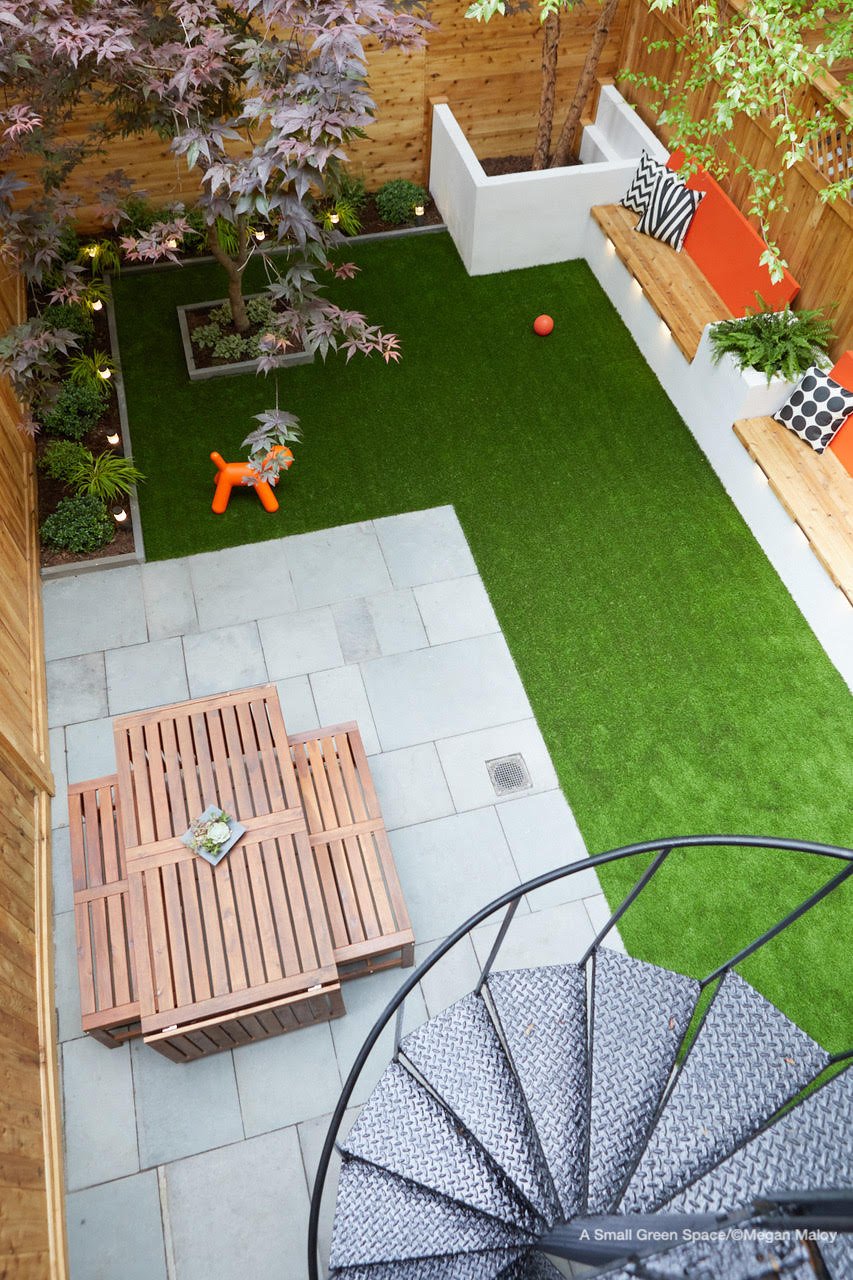6 Tips for Designing Small Outdoor Spaces
By Emma Lam, APLD Virtual Chapter Member and Marketing Committee Chair. Photos by Megan Maloy.
11 years ago, I founded A Small Green Space, a full service Garden Design, Build & Maintenance firm specializing in small urban spaces. We are based in Jersey City which is in the NYC metro area and our firm only works on urban spaces.
TIPS
1.Get To Know Your Space
Getting to know your outdoor space is integral to learning what works about the space and what doesn’t work for you. If you have just moved into your home and the outdoor space is new to you, stick a chair (any chair) out in the yard and go sit in it. Spend some time reading a book or surfing the web and see how you feel just “being” in your space. Then move the chair around the yard. Where does the sun hit and when? Is there a lot of noise (from neighbors, the street, A/C units etc.)? Where are the most “private areas”? Chances are that your small space will be visible to neighbors. Where do you experience this “in a fish-bowl” feeling the most/ least? What are the views from your space? Are you looking at neighboring buildings? Do you have a lovely tree to view? Discover what is beautiful/ interesting/ stimulating and plan to “highlight” it within your design. If you don’t find anything within your existing space that inspires you, start thinking about what focal points you might add. Perhaps a mural, a piece of sculpture, a beautiful plant/ tree/ shrub, or even an interesting fence. Don’t forget to get to know the structural components of your space too. What is the drainage like? If you are not sure about this, wait until you have a heavy rain or snowfall and go outside to investigate for collecting moisture and or slow draining puddles. Do you need a new fence? Are there trees that need pruning/ assessing?
Make a list of all the things you learn about your space and decide what you can tackle and what requires professional help.
2. Decide What you Want Your Space to Be
Don’t think of your outdoor space as a “yard”. Think of it as an outdoor room. And then decide what you want that room to be. Is it a living room? A dining room? A playroom? A relaxation room? A kitchen garden room? Or perhaps it’s a combination of more than one of these things. Once you know what you want to do in your space, you can plan how to do it. Don’t be afraid to want too much nor to question your answers. For instance, if you mostly want a space that you can relax and have cocktails with your friends in and will only occasionally fire up the BBQ, do you really need a distinct dining area? If you don’t eat outside very often, you may not want to use up precious space with a table. Likewise, if you have children and want them to be able to use the space do you need to turn it into a playground? Or will a child friendly outdoor “living room” suffice? Don’t let others define what a “yard” should and shouldn’t be. Instead have a conversation with yourself about what you want YOUR space to be.
3. Know the Value of Multi-Functional Elements and Thinking Outside the Box
If you think that you need a table but realistically you are only going to use it 2-4 times a season, then consider forgoing the table, and using a multifunctional bench or stool. A bench or stool without the back can be used as a makeshift table or a seat. Push two backless benches together throw some pillow seats on the ground, and you have a dining room sized table. Or what about a folding table? This way it can be stored out of the way, (under the deck, down the alley, in the mudroom, under the outdoor couch), until it is needed. And even a simple plastic table can be “jazzed up” by throwing a tablecloth over it.
Another example is an outdoor chalkboard. This can be used by the kiddies during play time but also showcase your cocktail menu for adult garden parties.
You don’t think that you have room for a fire-pit? What about getting a fire-pit with a removable table-top. This way your fire-pit can double as your coffee table.
If your tiny balcony does not have room for a lounge chair, consider using an outdoor dining chair with arms. Most of the time these are at least 12” narrower than lounge chairs and often just as comfortable!
Remember to be flexible and open to all possibilities while dreaming up your design.
4. Get the Layout of Your Space on Paper
Don’t be intimidated by this step. You do not have to be a professional designer or artist to get a sketch on paper! But sketching to scale will help. You can use an online program such as Google Sketch Up or simply buy some grid paper. Make each square on the grid represent a foot in length/ depth. Once you have the outline of your space you can see how much space you must work with and start playing! You can draw and cut out scaled mock-ups of different elements you would like to see within your space (such as benches/ couches/ chairs/ grills/ tables etc.). Move the mock-ups around the sketch of your space and see where they make the most sense. But don’t only look at size, think about practicality too. If your grill is closer to your kitchen door, the likely hood is it will be easier to use. If your table is close to the grill meals will be easier to serve and clean up. Are you a sun worshipper and want to lounge on a chaise in the sun? Or do you prefer to sit in the shade?
Keep all these questions in mind when drafting your design ideas.
5. Sometimes Size Does Matter and Every Inch Counts!
You may think installing a smaller patio will cost less and allows for a larger lawn. But is it big enough for you to walk around the table, pull the chairs out and sit down? Take a close look at the dimensions of furniture and outdoor accessories you are thinking of installing. If you think you have room to install a small shed, made sure that you also have room to open the door!
Much of the outdoor furniture available on the market is designed for large suburban yards. In a smaller yard even 6” can make a HUGE difference to the usability of your space. Don’t overlook entrances into the space. If you are blessed enough to have an alley, make sure that the elements you plan to add to your space, fit down that alley! If you do not have an alley and entrance is gained through your house, make sure to measure your doors/ windows and hallways to discover what will fit and what will not. And then plan accordingly!
6. Don’t Forget the Plants!
After all this is an “outdoor” space. I view all the spaces we work on as “gardens” regardless of how many plants are in them. There are many questions to ask when deciding what to plant in a space. It’s true that your planting zone and the amount of sun/shade you have will affect your planting options. But don’t be afraid to take chances! The benefit of having a small planting area, is that it’s not too difficult to “do-over” if the plantings don’t work out the first time around!
When we design our planting plans, we try to keep in mind that our small planting areas ideally need to have a big impact. So once again we look to multi-functionality. With a 2’ deep planting bed, or a 12” container, we do not have the luxury of layering many plants within them. Therefore, we must make sure that each plant has an impact that ideally lasts throughout the entire growing season. A plant that has lovely flowers for 6 weeks but not much else going on, can look great layered in a large suburban or rural planting bed. But in a small bed it wastes precious space. Instead, we look for plants that have interesting foliage, shapes, and/or textures, as well as flowers to have something inspiring to look at all year long.
And don’t overlook the importance of stimulating your other 4 senses too. Seek out plants with movement that produce sound (such as ornamental grasses and weeping trees); plants that you can touch (such as lambs-ear and pussy willow); plants with aroma (such as herbs and flowers); and/or edible plants (such as fruits, veggies, and edible flowers).
Size appropriate plantings are key. In my opinion a 40-foot-tall tree has no business in most small urban back yards, and I view them as “irresponsible plantings”. Not only can these large beings cause huge problems in small spaces, (roots under patios and getting into foundations, hazardous falling branches etc.), but it is also very difficult to care for a large tree in a small urban space. If the only access to your site is through the house or down a narrow alley, this does not allow for the proper equipment nor safety procedures required to adequately prune and care for a large tree. Keep this in mind when choosing plants and make sure to read their tags. The 18” evergreen shrub you found at the garden center might look perfect in your 2’ deep planting bed now, but if the mature size of that same shrub is 5’x 5’, it will quickly overwhelm both you and your space.
The most important tip I can give when it comes to caring for your plants is to make sure to WATER them. I have never seen a well-draining outdoor garden die from too much water, but I have seen many perish from too little.
Finally, think outside the box when considering where to plant in a small space. You do not have to have an in-ground planting bed to make your space a garden. Containers; living-walls; green-roofs on sheds; hanging baskets; window boxes; raised beds; and/or furniture with built-in planters etc. can all be areas where life can grow and thrive.
All plants will speak to you in different ways and help to create a comfortable and inviting living space that you will find yourself wanting to spend time in.
SUMMARY
So, in conclusion, view your small outdoor space as an additional room of your house. Don’t overlook its importance within your home and your life. In my opinion, a space you can “live” outside in, is invaluable no matter how small it is.
No space is too small to be green, and I truly believe that the possibilities for our small outdoor spaces are only as limited as our imaginations!




